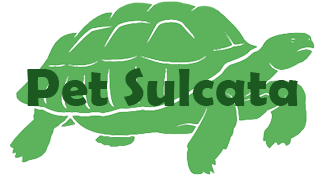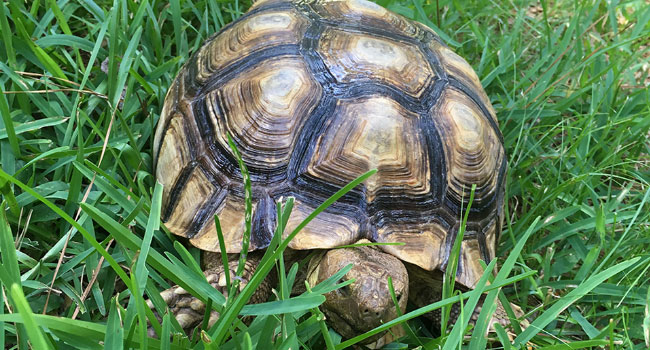
Sulcata tortoises, also known as African spurred tortoise or Geochelone Centrochelys sulcata, are the third largest tortoise species. They grow up to 2.5 feet long and 80-110 pounds. Some males will even reach upwards to 200 pounds. Sometimes, sulcatas will reach this size within 5-10 years. It’s not uncommon to find a 15 pound 2-3 year old sulcata tortoise.
Raised on a high-fiber diet with proper environments, sulcata tortoises can live up to and over 70 years.
Housing
Sulcata tortoises grow fast and grow large. They are not meant to stay in a small, cramped aquarium nor a small plastic tote for long. For baby sulcatas, plan on buying the larges Sterlite to or enclosure that you can, but plan on it only lasting a year or less. For larger sulcatas, plan on making a safe outdoor enclosure or tortoise-proofing your yard.
Enclosure Size
The bigger the better. Even with baby sulcata tortoises, you want a big enclosure. One baby sulcata needs about a 4-foot by 18-inch enclosure. A Christmas tree tote makes a sufficient enclosure for a baby sulcata.
Sulcatas do not typically do well in stuffed, small enclosures. Once you add the water dish, food bowl, hides and any decorations, there isn’t a lot of walking room. Even a 4-foot by 8-foot enclosure can become too small in a year or two.
Adults need an outdoor space of about 16-foot by 20-foot. Again, the larger space, the better.
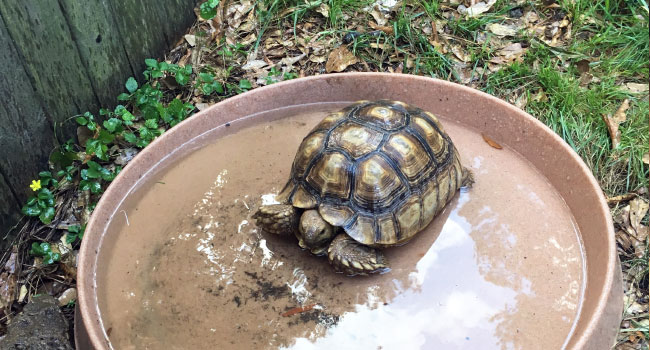
Substrate
For indoor enclosures, use a substrate that will hold in humidity. Stick with coco coir, orchid bark, cypress mulch or top soil.
Do not use wood shavings, newspaper pellets, hay or sand.
Humidity
When housing young sulcatas, it’s important to have optimal humidity in order to prevent pyramiding. In the wild, sulcatas hatch during the rainy season and spend a lot of time in underground burrows where humidity is higher. In order to replicate this in captivity, use substrate that will hold humidity. Also, consider buying, building or customizing a closed chamber enclosure.
Try to maintain 80% humidity.
Offer a humid hide for the tortoise to retreat to. In the humid hide, you can attach a sponge to the ceiling of the hide and keep it damp. Some keepers use moss, but be careful that the tortoise doesn’t try to eat the moss.
Heating and Lighting
You want to mimic a natural setting as best as you can. Use a timer for a 12 hour day.
The basking area should be 100-degrees Fahrenheit.
The ambient temperature in the rest of the enclosure should be around 80 – 90-degrees Fahrenheit.
Night temperatures should not dip below 70-degrees.
UV
Tortoises need UV lighting. Natural sunshine is best, but when setting up an indoor sulcata enclosure, use an artificial UV bulb or UV tube.
Diet
Sulcata tortoises are primarily grass eaters. A healthy diet should include about 80% grass, weeds and hay. Sulcatas are a grazing species. It is vital that grass play a large part in the diet.
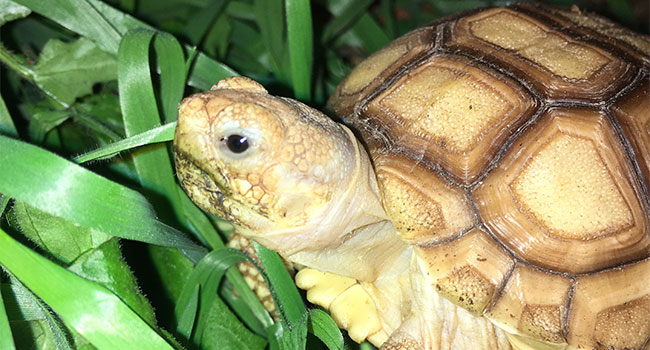
Food
Below are a few safe foods for sulcatas. Do not limit a sulcata to these foods. Provide as much variation as you can to ensure the tortoise is consuming a variety of vitamins and nutrients.
Safe grass for sulcata tortoise:
- Barley grass
- Bermuda grass
- Buffalo grass
- Fescue grass
- Kentucky blue grass
- Oat grass
- Orchard grass
- Rye grass
- Timothy grass
- Wheat grass
Safe weeds for sulcatas:
- Cats ear
- Chia
- Chick weed
- Clovers
- Dandelion weeds
- Geranium
- Mallow
- Moringa
- Nettles
- Plantains (Broadleaf and Narrow Leaf)
- Sow thistle
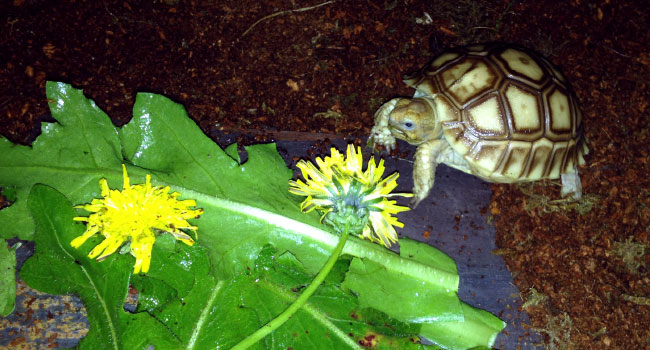
Safe Plants for sulcata tortoises
- Grapevine leaves
- Hostas
- Hibiscus leaves
- Honeysuckles
- Mulberry leaves
Grocery store lettuces that can be incorporated into a sulcata diet include:
- Arugula
- Bok choy (sometimes)
- Collard greens (sometimes)
- Endive
- Escarole
- Grape leaf
- Mustard greens (sometimes)
- Oakleaf
- Radicchio
- Spring Mix lettuces
Mazuri and Zoo Med Grassland pellets for tortoises can be fed 1-3 times a week. You can offer 100% hay pellets and cubes more often, but feed with a varied diet.
Do not offer fruits. Fruits are high in sugars that are hard to digest and can raise the pH levels in the digestive tract. An increased pH level can kill good bacteria, causing health problems
Do not offer animal proteins. Sulcatas get all the protein that they need in their diets from the grasses and plants.
Healthy treats include Optunia cactus pads and flowers, like roses and hibiscus. If you can’t find fresh flowers, dried flowers are also tasty treats to add to your tortoise’s food.
Water
Soak baby tortoises for about 20-30 minutes every day. Use warm water (about 85-degrees).
Also, keep a water bowl with fresh water in the enclosure at all times.
Supplementation
Cuttle bone is a great source of calcium, but not all tortoises will eat it. You can still have it available in the enclosure.
Tortoises that do not have access to outdoor enclosures, or during the winter when it’s just too cold to go outside, use a calcium + D3 supplement twice a week. For tortoises that are able to spend sufficient time outside, use a calcium supplement without D3.
A multi-vitamin can also be offered once a week.
